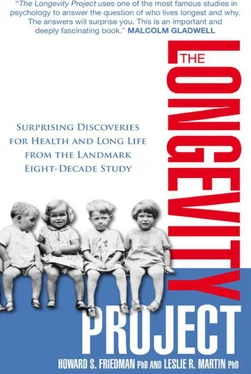A striking theme emerged from our findings about those individuals—usually women—who often ignored social convention. Emma followed a life path that many young women of her era tried to avoid: She never married. She pursued her career with passion and her life was rewarding and full. She traveled. She was independent yet had a group of close friends (and her siblings) to share her joys and to encourage her during difficult times. Emma’s reports to Terman over the years don’t reflect a woman who felt her life was incomplete. Instead they suggest a spirited woman, very agreeable but serious, taking advantage of the opportunities afforded her. Although a good marriage can contribute to health and well-being, marriage can also bring troubles, plus the possibility of breakup and its health-damaging consequences.
Barbara, altruistic and agreeable, began her adulthood more conventionally than did Emma—she got married. But then she, too, headed down a less-traveled road. She was divorced, and she chose not to remarry. Like many of the women, but not the men, who divorced, she stayed healthy. She had close friends, as did Emma, and Barbara’s career in social work provided her with many opportunities to reach out to others. As was the case for many of the Terman women, Barbara’s life revealed an unexpected but common, healthy path for a woman—staying single after a divorce.
The highly successful Hollywood director Edward Dmytryk, one of the hardest-working Terman subjects, led one of the most stressful lives yet lived to age ninety. Those who cared about others—who were agreeable but not necessarily sociable—often thrived even in the face of adversity. Like Dmytryk, they sought out the best in others, which was a key road to resilience. The same could be said of those children who faced the divorce of their parents. Those who got back on track, with a sense of accomplishment in their careers and a happy marriage of their own, lived long lives.
We didn’t find that competition and drive are unhealthy characteristics. On the contrary, those who were the most disappointed with their achievements died the youngest. It would be naïve to think that successful Hollywood directors like Dmytryk, TV writers like Jess Oppenheimer, and the like cannot compete and throw an elbow at their opponent if needed. But they had the persistence, the motivation, and especially the support of a spouse or a close friend to come back each time they faced a challenge. Resilience was not a trait they were born with, nor an inner insight, but a process of perseverance and hard work.
The Long and Winding Road
Many of the Terman children were on a very healthy trajectory in the first third of their lives—they were more physically active (especially the boys), were well-adjusted, and had many friends and teammates. But by age sixty, most of them had lost vigor and energy (and tended now to resemble those who had been less active). Their childhood activity levels didn’t translate directly to living longer. Instead, it was those who started active and stayed active, and those who started out less active but increased (and maintained) their activity, who lived the longest.
Staying physically active was clearly important to good health and long life. But it was not those who made resolutions to go running who succeeded. Rather, it was those whose habits, routines, and social networks encouraged movement and made it difficult to sit in one place who did well. The Terman participants lived most of their lives before the popular availability of jogging trails and marathons, gyms and treadmills, and running shoes and sweat-wicking athletic attire. Yet many stayed active, trim, and fit. Modern developments in the exercise industry can help individuals optimize and improve their fitness, but it is the broader patterns that lead one to maintain this fitness throughout many years.
An analogous finding emerged with conscientiousness. It was those who were conscientious as children and who remained highly persistent and prudent as adults who lived the longest. Nevertheless, those who started out unconscientious but entered positions requiring maturity and growth, and who increased their levels of prudence and persistence, were able to close much of the gap. Such patterns, common among the Terman subjects, revealed that there were inclinations and patterns launched in childhood, but little was fixed and determined at an early age. Rather, it was those who stayed on the healthiest paths, plus those who found their ways to the healthiest paths, who thrived in the second half of life.
The Feminine Avenue—Establishing Social and Emotional Ties
Many of the Terman men tended to rely on their wives for their social ties and their emotional health. When these were lost due to divorce or death, the consequences were often devastating. Among men, those who were in stable married relationships lived the longest. But the same was not true for the women. As noted, the women could more easily establish social and emotional ties with others. Those Terman subjects—male or female—who could nurture the feminine quality of social connectedness stayed healthier. The more masculine men and the more masculine women died sooner, while the more feminine women and the more feminine men lived longer.
The Less Sunny Side of the Street
Unlike catastrophizing, moderate worrying often conferred real benefits to health. James, tactful and sensitive, was something of a worrier throughout his life. But it turned out that his concerns prompted him to take better care of his health, especially after the death of his wife. Particularly for those with no spouse or close family member to urge them in the right direction, and especially for men, neurotic tendencies can promote longevity. Neurotic worrying as part of a syndrome of catastrophizing, anger, and depression was a sign of heightened risk, but for many people, nagging thoughts and irksome concerns were important to heading toward better health. This, too, was an unexpected finding that goes against common wisdom.
So there’s no need for worriers to fret that this trait will threaten their health. Unless your worrying is disrupting your friendships or impairing your work, it can come in handy (and be health promoting) when you’re facing various challenges needing thoughtful consideration.
Religious individuals tend to live longer. In part, this is due to their healthier lifestyles, which is not at all surprising. And sometimes this long-life advantage is a phony finding, which emerges because some unhealthy people may be less able to be active in religious life. But what is it about religious involvement, especially for women, that goes beyond these simple matters? Feeling special and appreciated was not a key element of health. The calming aspects of prayer, meditation, and so on likewise did not emerge as of central importance, although they certainly help some individuals deal with acute stress. Instead it was that many religious individuals (and many nonreligious Terman subjects) were actively involved in their communities. They had close friends and social ties they could rely on. Those who were engaged with others lived longer lives.
Donna’s life eventually followed the unholy way. Somewhat involved in religion during the first part of her life, she drifted away from her church over time. She was divorced, and busy with a demanding job in advertising, without much time for friends. This was congruent with her other more masculine characteristics. When she left her congregation, she created a real deficit in her life. People like Donna likely would have done much better if they had maintained close social contacts, whether through church organizations or similar groups. The divorce of her parents seems to have set her down a path in which one health threat followed another. Even a polypill would not have saved her.
Читать дальше











